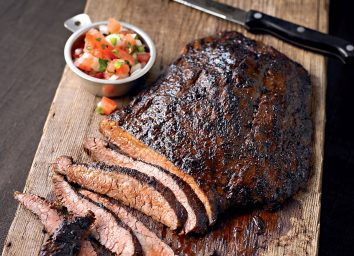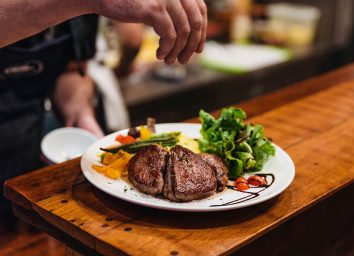The Best & Worst Cuts of Steak—Ranked by Nutrition
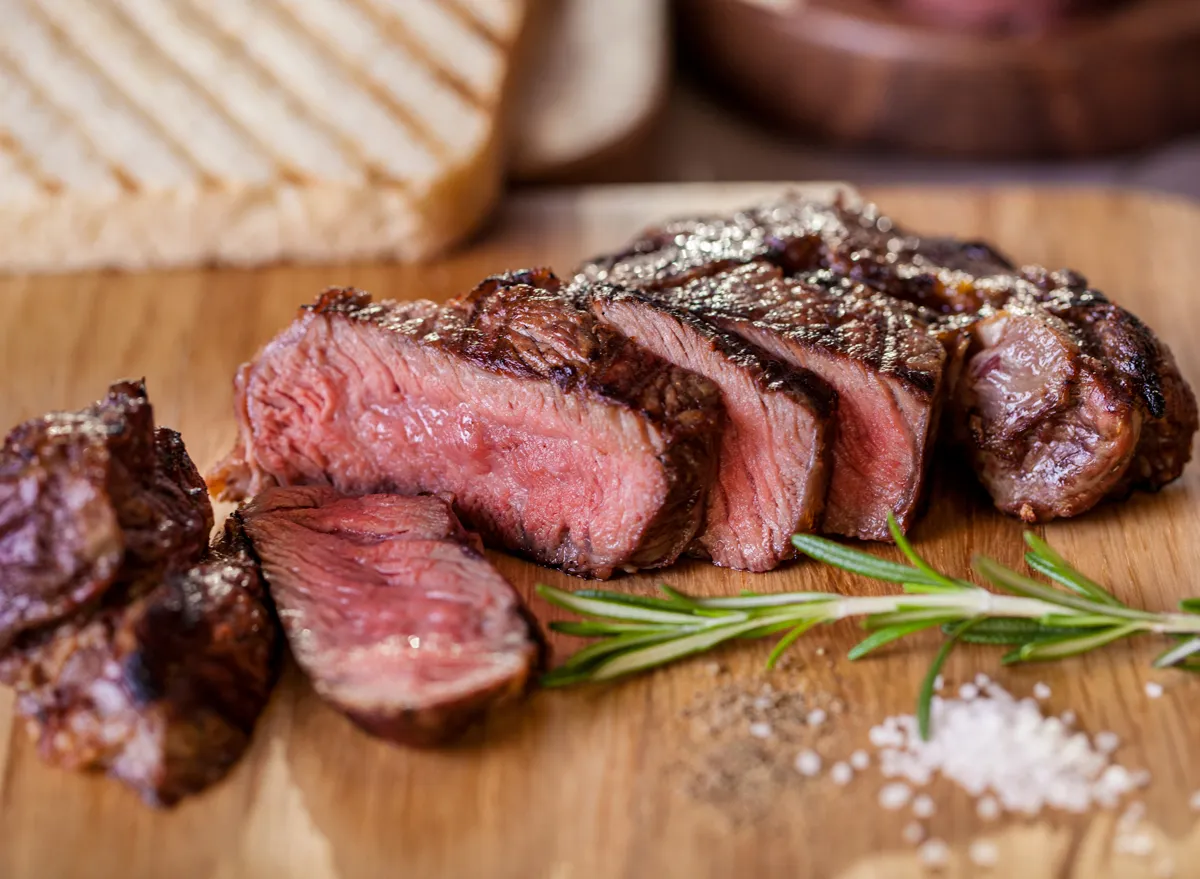
Whether it’s grilling season or not, steak is a favorite among meat lovers. In fact, nearly half of Americans say they eat steak at least once a week, according to a survey by the National Cattlemen’s Beef Association. But when it comes to steak nutrition, different cuts offer varying levels of health benefits—or risks. So, what’s the healthiest cut of steak, and how does red meat fit into a healthy diet?
Steak is rich in essential nutrients and an excellent source of protein. Registered dietitian Lara Clevenger, MSH, RDN, CPT tells us that steak provides “healthy fat-soluble vitamins, iron, and vitamin B12,” making even higher-fat like ribeye cuts a nutrient-rich choice when enjoyed in moderation.
Even though steak is a great source of nutrients, how much and how often you eat steak makes a difference in your health. The American Institute for Cancer Research recommends limiting red meat intake to 18 ounces per week to reduce cancer risk. Opting for leaner cuts and keeping portions in check can help you enjoy steak as part of a balanced diet.
To help you choose the healthiest cut of steak, we’ve ranked 11 popular options from best to worst, based on calories, total fat, and saturated fat. Read on to learn more about steak nutrition, and for more tips, don’t miss 5 Healthiest Meats To Eat, According to Dietitians.
Every Steak Cut, Ranked by Nutrition from Best to Worst
- London Broil
- New York Strip Steak
- Bottom Round Steak
- Filet Mignon
- Top Sirloin Steak
- Flat Iron Steak
- Flap Steak
- Skirt Steak
- T-Bone & Porterhouse Steaks
- Delmonico Steak (Chuck Eye)
- Ribeye Steak
The Healthiest Cut of Steak: London Broil
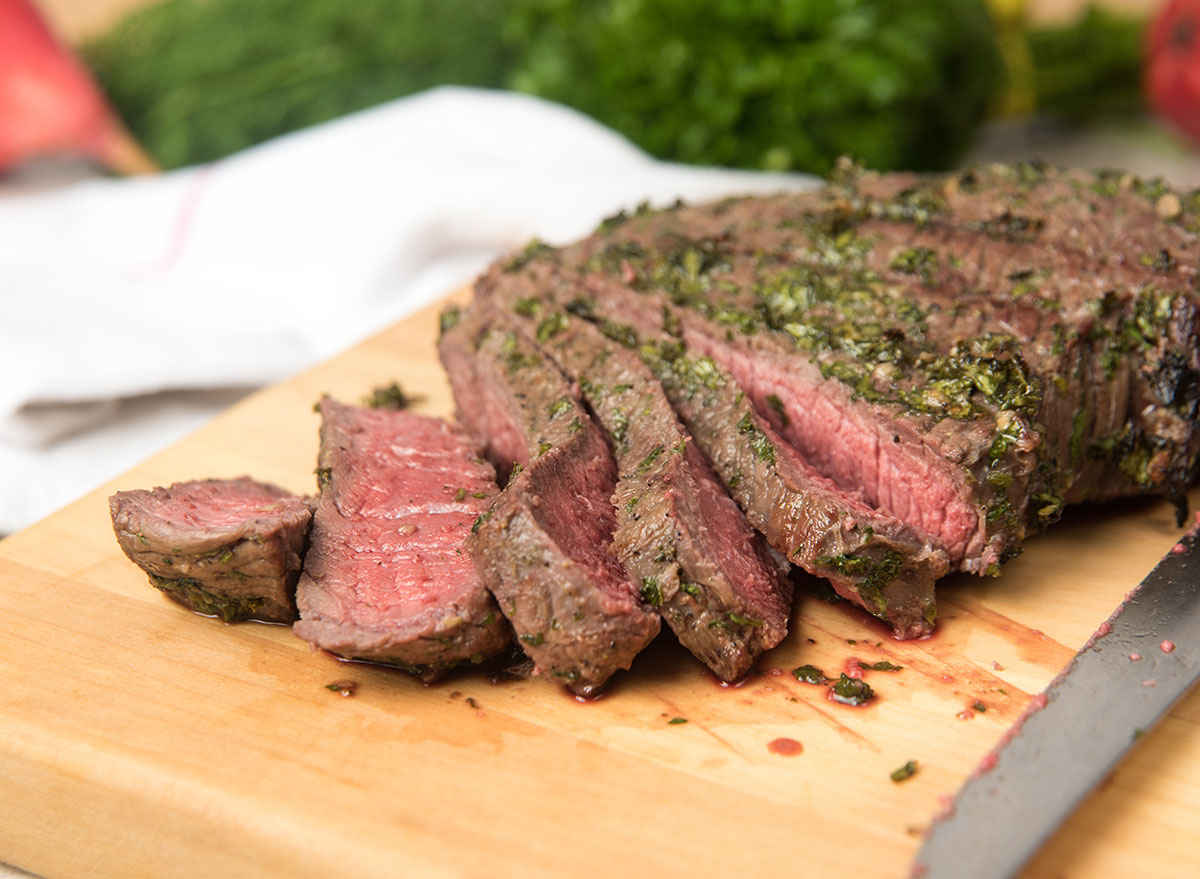
Calories: 216
Fat: 7 g (Saturated Fat: 3 g)
Sodium: 45 mg
Carbs: 0 g (Fiber: 0 g, Sugar: 0 g)
Protein: 36 g
Top round steaks, also known as a London Broil, are a high-protein, low-fat option that’s often considered one of the healthiest cuts of steak. With just 7 grams of fat per serving and a whopping 36 grams of protein, they’re a lean choice for those watching their fat intake.
However, these cuts can be tough due to their origin from well-used muscles, so proper preparation is key. For a tender and juicy London Broil, follow the name’s suggestion—broil or braise it low and slow to break down the tough muscle fibers.
New York Strip Steak
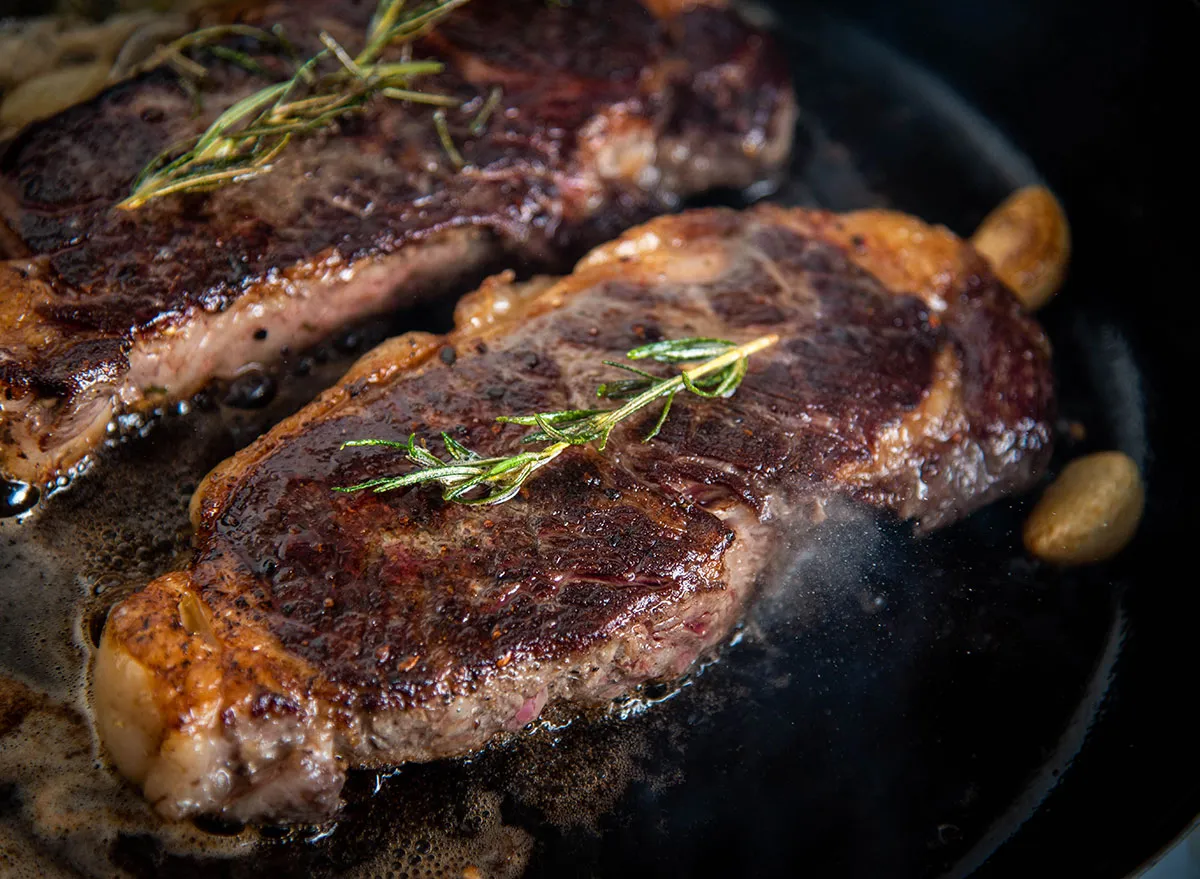
Calories: 150
Fat: 6 g (Saturated Fat: 3 g)
Sodium: 45 mg
Carbs: 0 g (Fiber: 0 g, Sugar: 0 g)
Protein: 23 g
A New York Strip is one of the leanest cuts of steak that’s also high in protein with 23 grams per 100-gram, or 3.5-ounce serving. You may also see this cut called Kansas City steak, Hotel-style steak, top loin, or shell steak. Even without the high amount of fat, it has a buttery texture and full flavor.
Bottom Round Steak
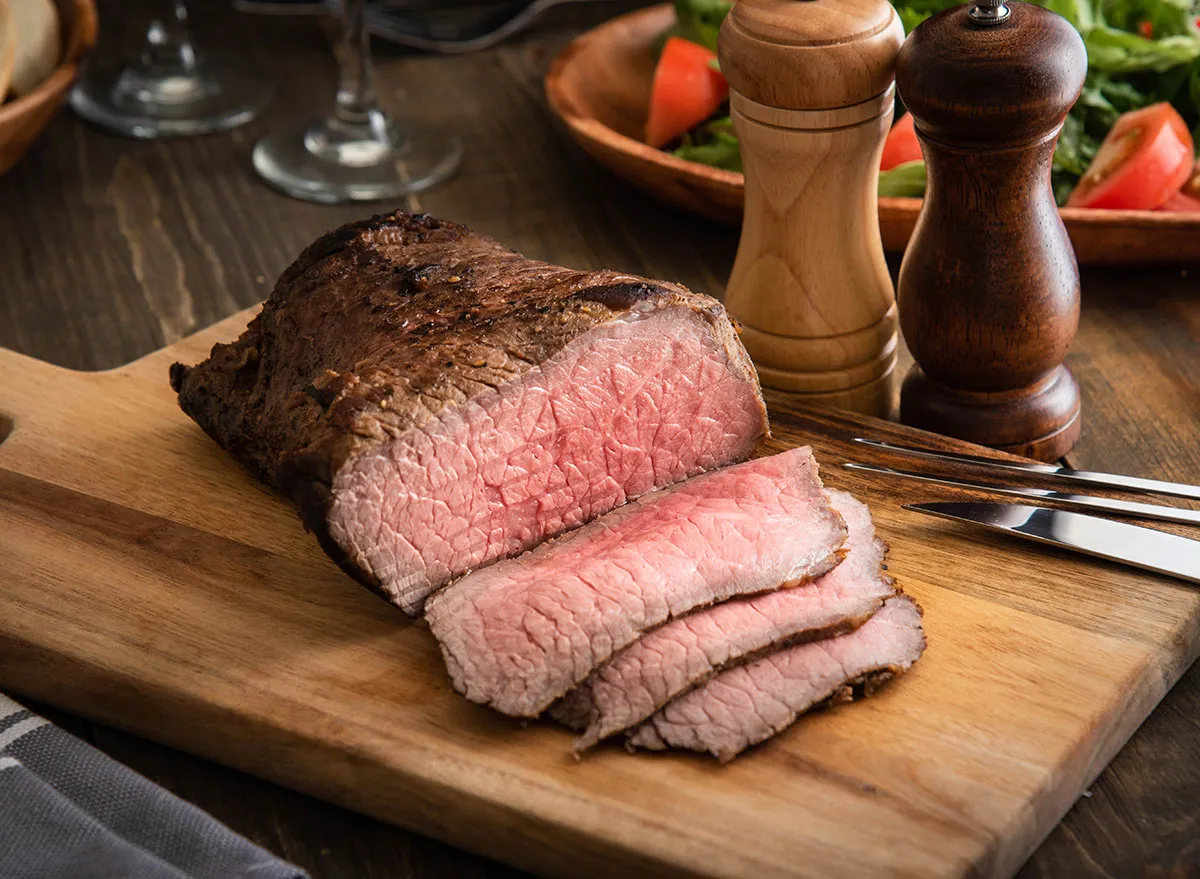
Calories: 191
Fat: 8 g (Saturated Fat: 3 g)
Sodium: 57 mg
Carbs: 0 g (Fiber: 0 g, Sugar: 0 g)
Protein: 27.2 g
For a low-fat and high-protein cut, try the Bottom Round Steak. With just 8 grams of total fat and only 3 grams of saturated fat, a 100-gram or 3.5-ounce serving with only provide 14% of your total recommended limit of saturated fat. These are excellent cuts to marinate and serve family style, allowing you to easily serve a healthy 3-5 ounce portion.
Filet Mignon
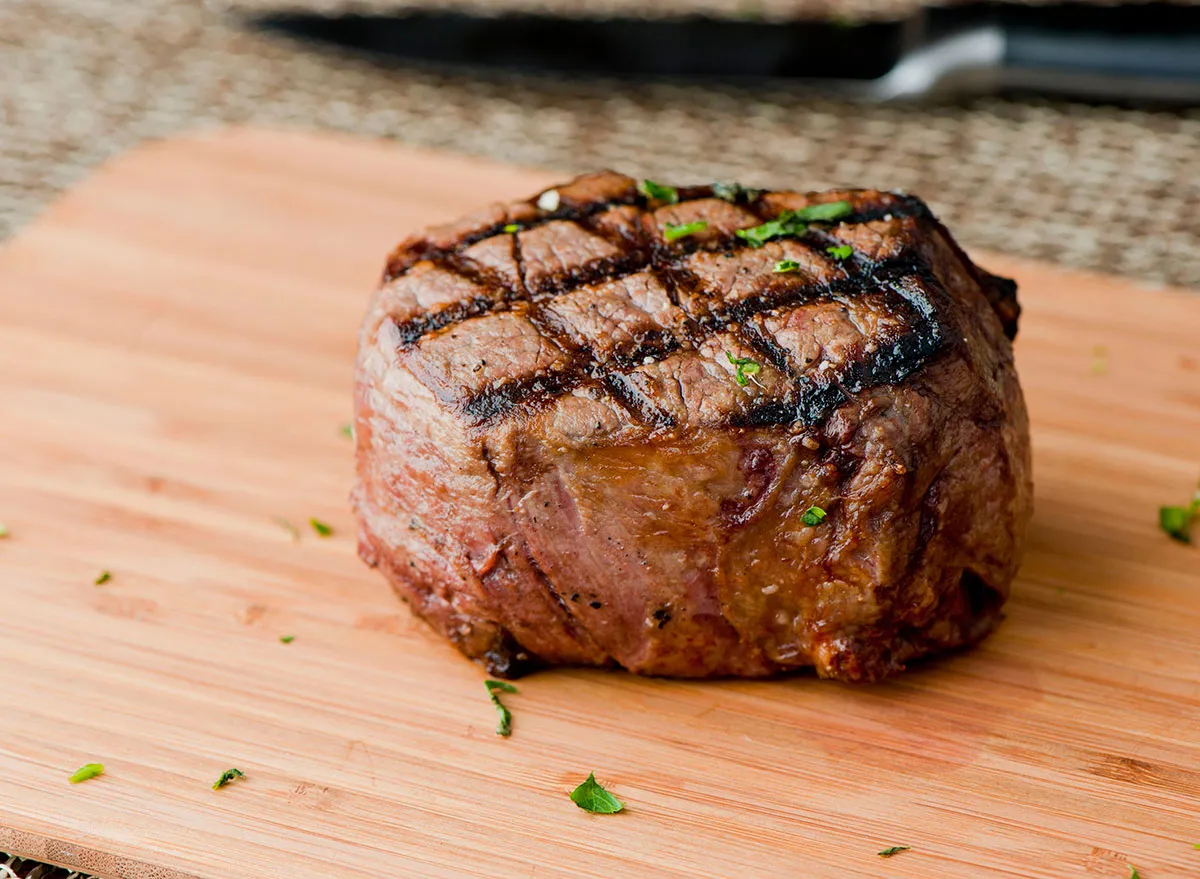
Calories: 217
Fat: 10 g (Saturated Fat: 4 g)
Sodium: 58 mg
Carbs: 0 g (Fiber: 0 g, Sugar: 0 g)
Protein: 30 g
“Filet Mignon is a very lean cut of beef and contains less fat compared to other cuts like ribeye or T-bone steak,” says Wan Na Chun, MPH, RD, CPT of One Pot Wellness. While it does have a reputation for being a lean cut, Filet Mignon gets its tender buttery texture and juicy flavor from 10 grams of fat, 4 grams of that saturated. This lower fat content can make it a healthier option for those looking to reduce their saturated fat intake, too much of which is associated with an increased risk of heart disease, adds Chun.
Top Sirloin Steak
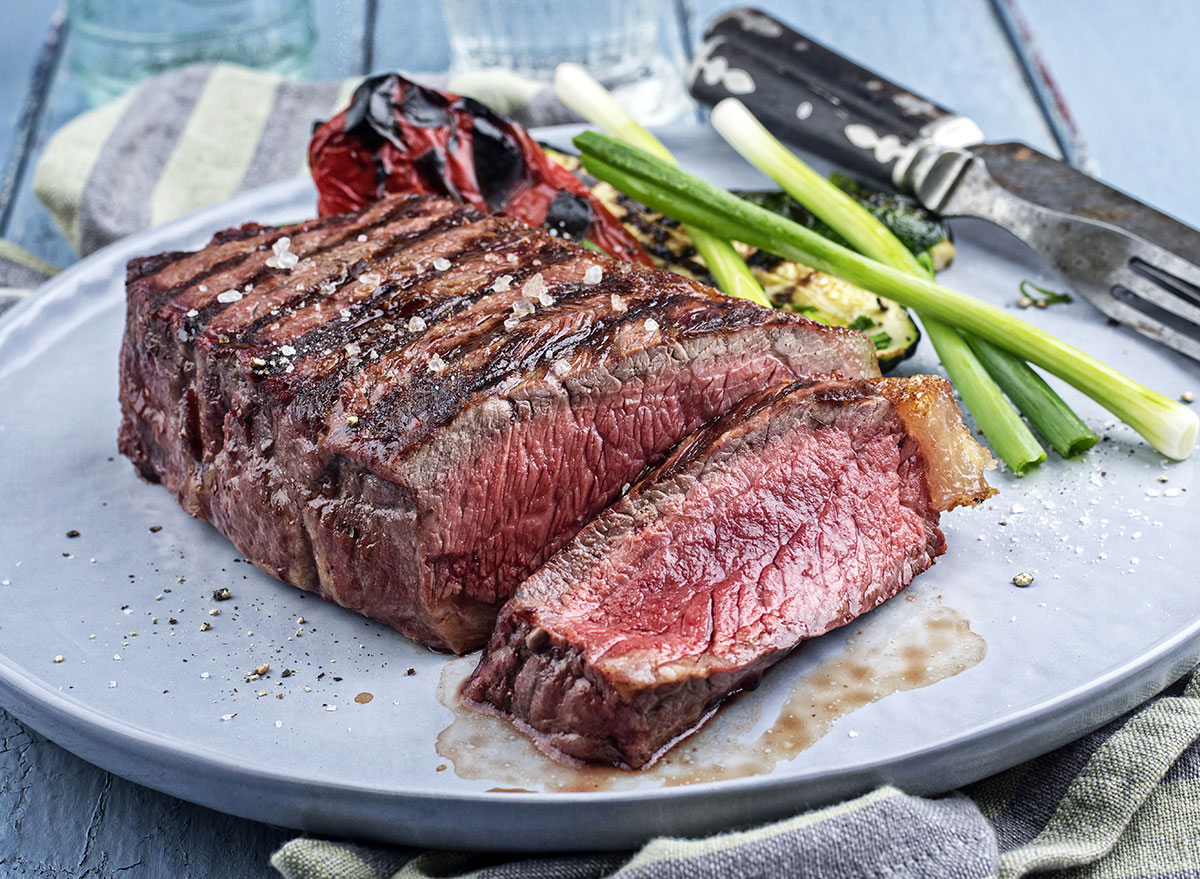
Calories: 219
Fat: 11 g (Saturated Fat: 4 g)
Sodium: 58 mg
Carbs: 0 g (Fiber: 0 g, Sugar: 0 g)
Protein: 29 g
Top sirloin is a super versatile cut of steak that’s relatively budget-friendly, tastes great grilled, and is also pretty low in fat with just 11 grams total and 4 grams of saturated fat per 100-gram serving. The fat content can change depending on trimming and the variation you select, but overall it’s one of the healthiest tender cuts.
Flat Iron Steak
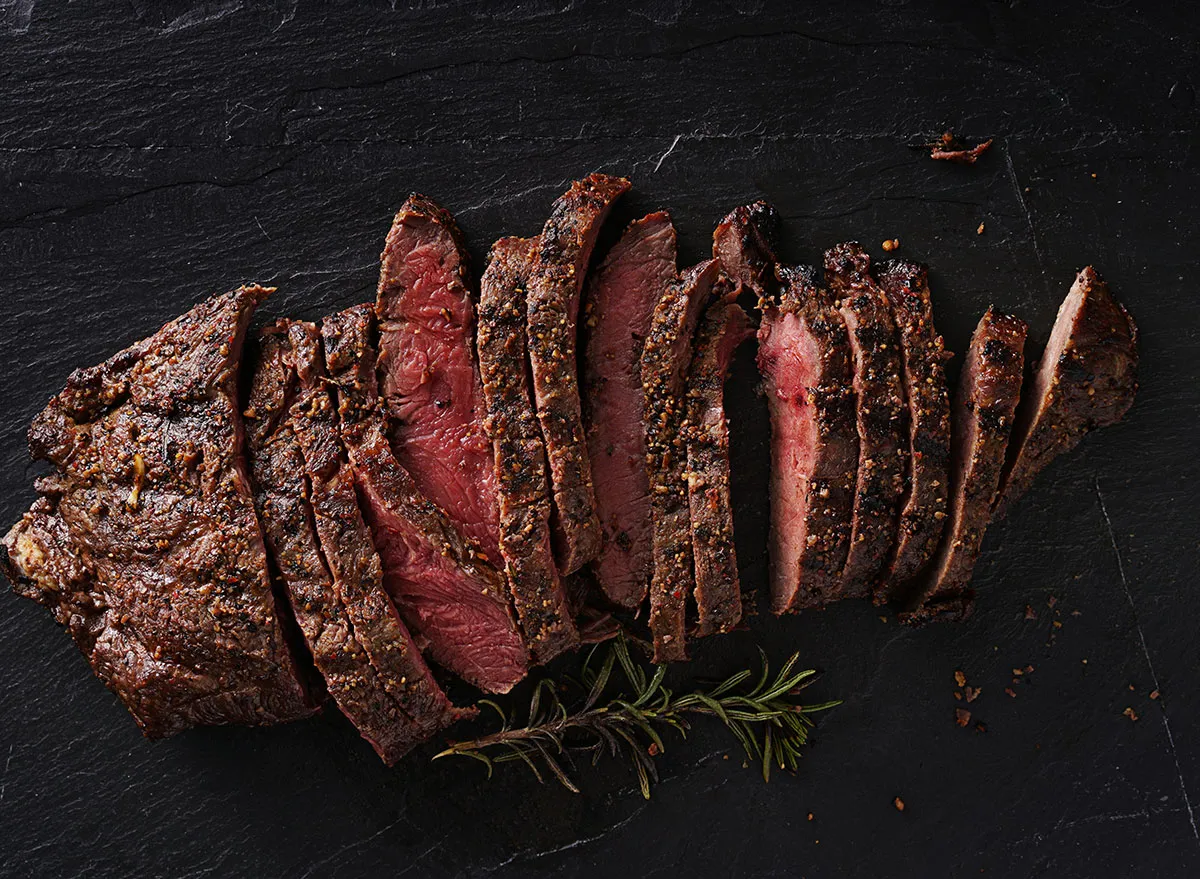
Calories: 228
Fat: 14 g (Saturated Fat: 5 g)
Sodium: 78 mg
Carbs: 0 g (Fiber: 0 g, Sugar: 0 g)
Protein: 25 g
A Flat Iron steak is also known as a Boneless Top Chuck steak, as it’s taken from the top blade. While not a super tough cut of meat, it is lower in fat and does have a section of tough gristle that needs to be removed. “These cuts tend to be less expensive and cooking them low and slow brings out their rich collagen, adding flavor without needing lots of extra fats,” says Celine Thompson, MS, RDN.
Flap Steak
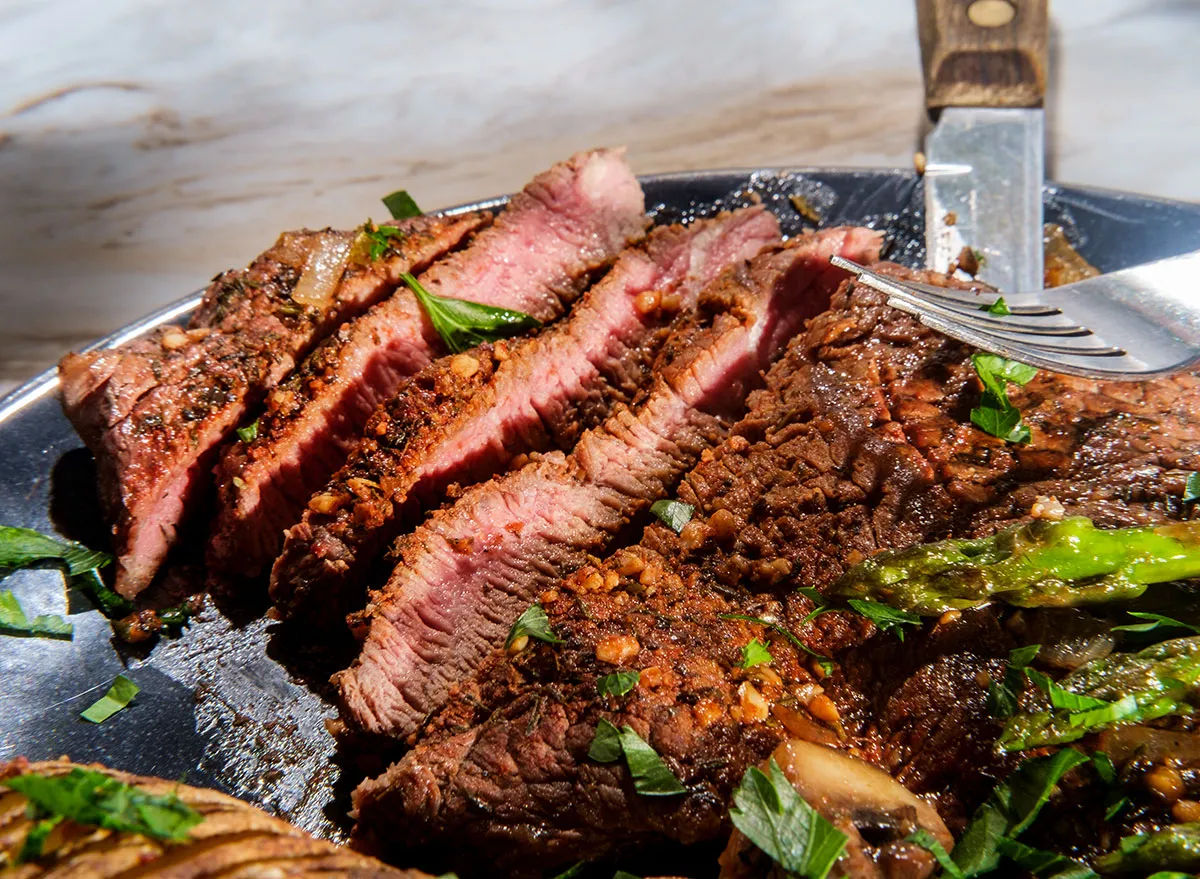
Calories: 196
Fat: 13 g (Saturated Fat: 4 g)
Sodium: 49 mg
Carbs: 0 g (Fiber: 0 g, Sugar: 0 g)
Protein: 20 g
“Packed with flavor, this lean cut provides a protein punch without breaking the bank,” says Jessie Hulsey RD, LD, an Atlanta-based registered dietitian. Each 100-gram serving of Flap Steak has just 4 grams of saturated fat, the equivalent of 18% of the recommended daily limit. “It’s not only a wallet-friendly option, but also a great source of protein, iron, and B vitamins, essential for a balanced diet,” Hulsey adds.
Skirt Steak
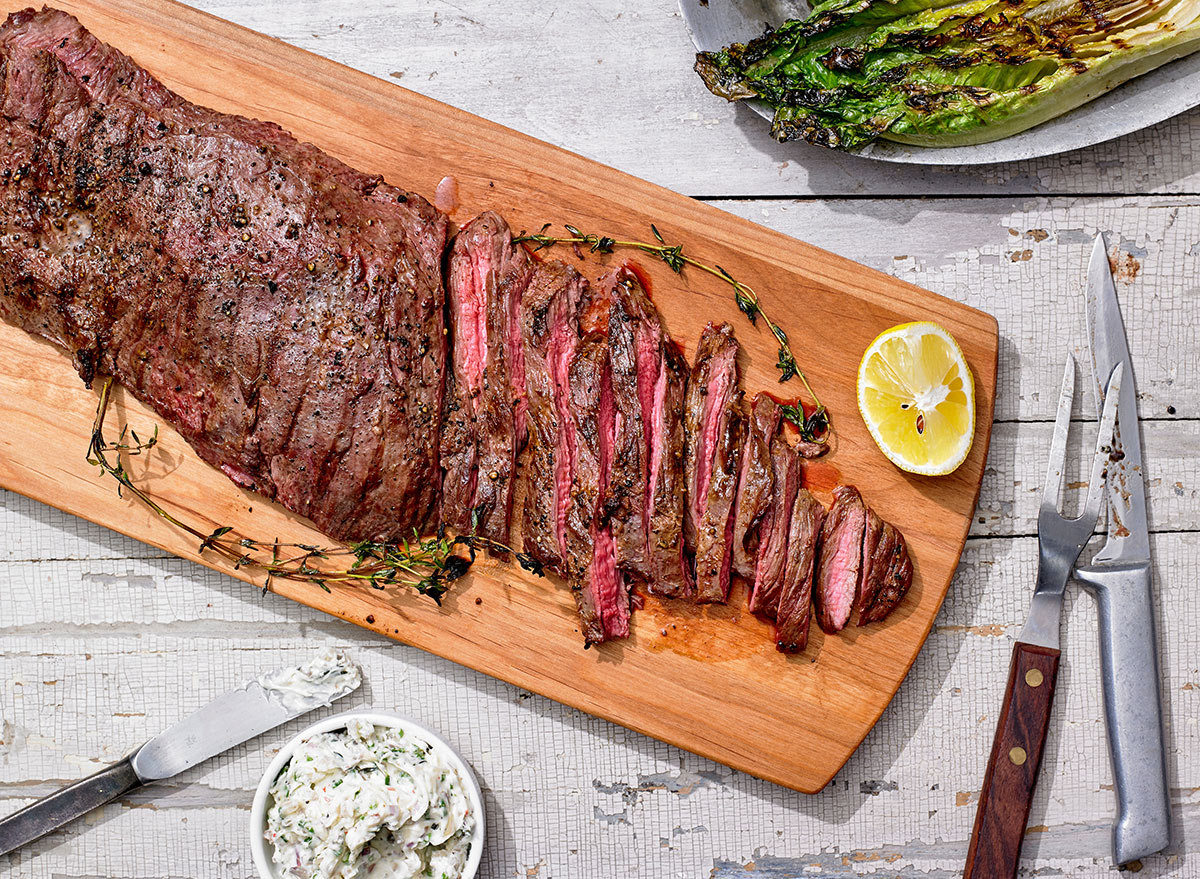
Calories: 253
Fat: 15 g (Saturated Fat: 6 g)
Sodium: 63 mg
Carbs: 0 g (Fiber: 0 g, Sugar: 0 g)
Protein: 29 g
Skirt steak is higher in protein than many other cuts while having just 6 grams, or 27% of the DV, of saturated fat per 100-gram serving. While it’s leaner than many other cuts of steak, it does still have 15 grams of fat per serving. The higher muscle percentage in this meat adds more protein but also adds a little more toughness compared to cuts that are even higher in fat and lower in protein.
T-Bone & Porterhouse Steaks
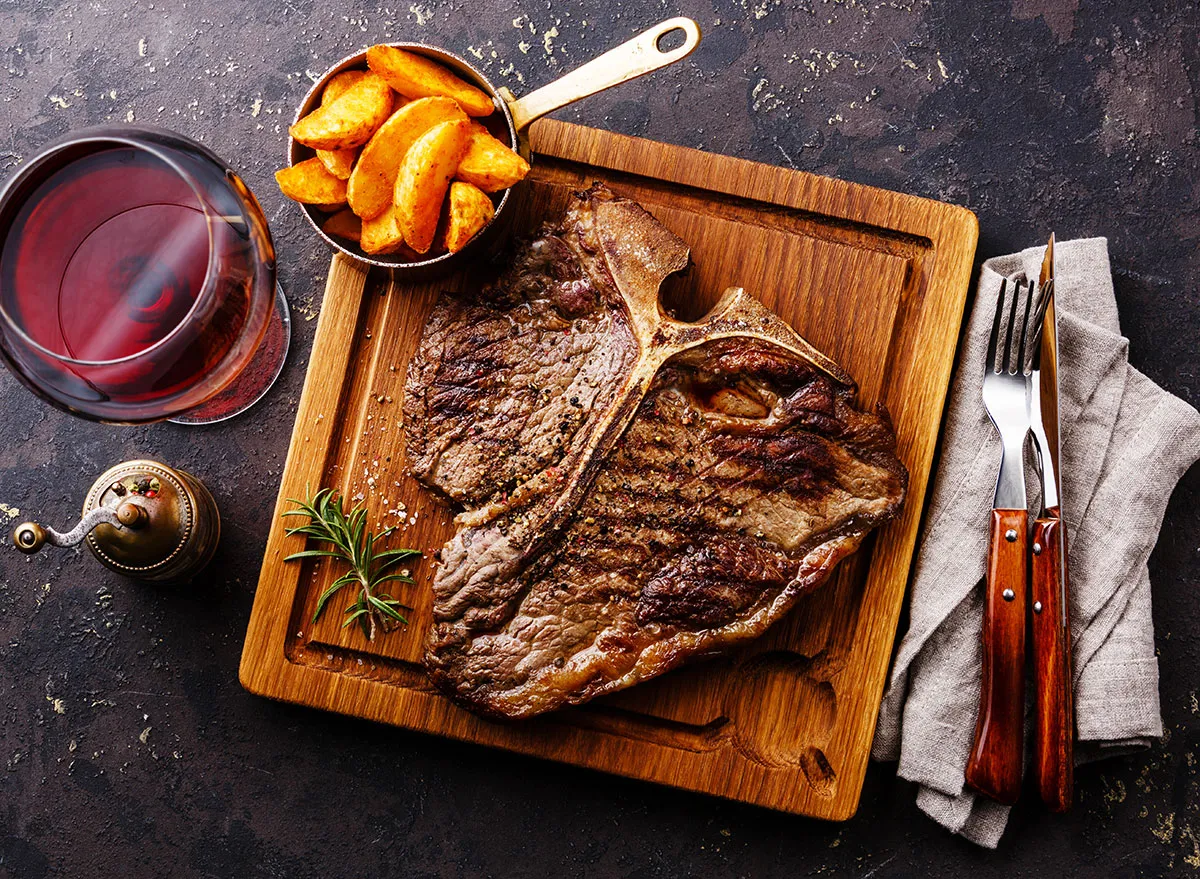
Calories: 250
Fat: 18 g (Saturated Fat: 7 g)
Sodium: 54 mg
Carbs: 0 g (Fiber: 0 g, Sugar: 0 g)
Protein: 21 g
Also known as a Porterhouse or King steak, this cut has a signature “T” dividing a New York Strip and filet mignon. Each 3-ounce serving has 7 grams of saturated fat, or 32% of the DV. However, a T-bone steak is seldom served in this small of a size, as a typical T-bone is between 12 and 18 ounces, the maximum amount of red meat that’s recommended to eat in an entire week.
Delmonico Steak (Chuck Eye)
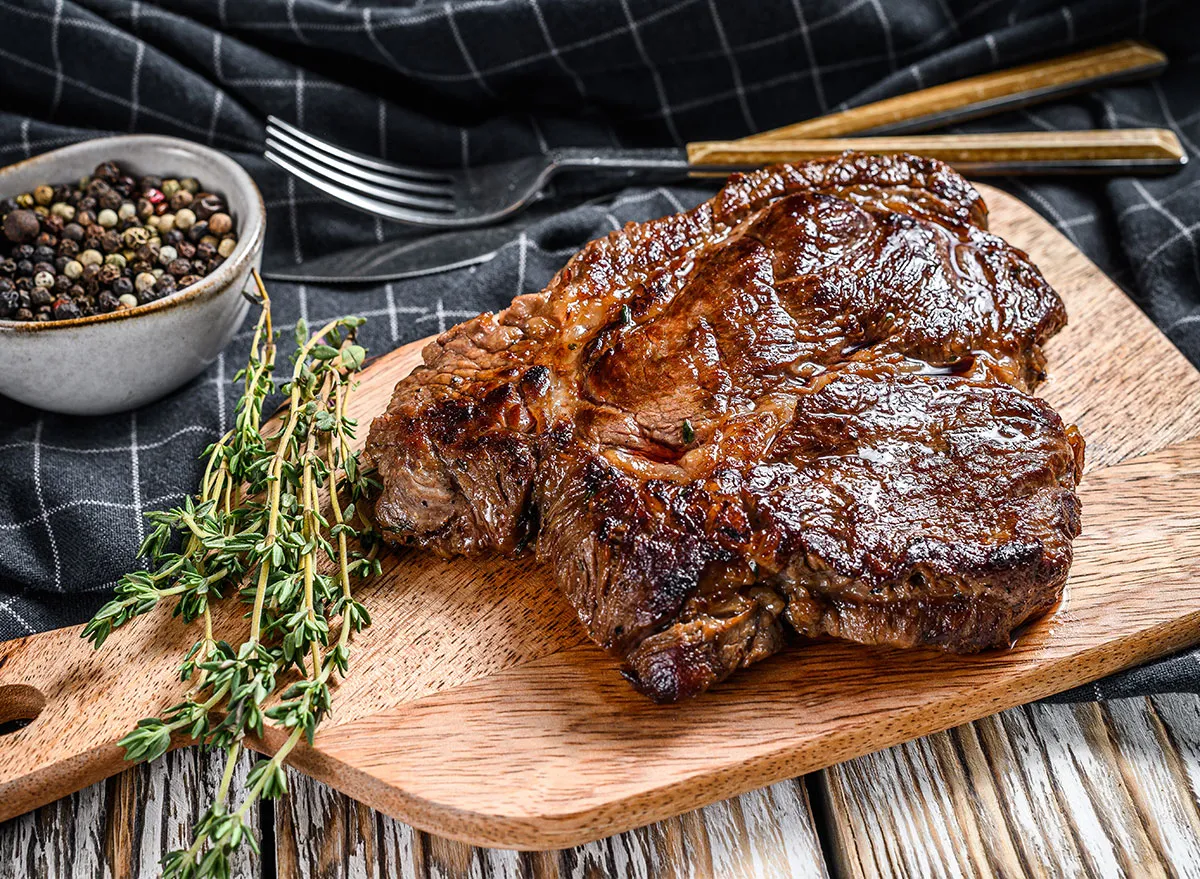
Calories: 235
Fat: 17 g (Saturated Fat: 7 g)
Sodium: 60 mg
Carbs: 0 g (Fiber: 0 g, Sugar: 0 g)
Protein: 21 g
Each 3.5-ounce portion of Delmonico or Chuck Eye Steak has 17 grams of fat and 7 grams of saturated fat. While this is only 32% of the DV for saturated fat, a typical serving of Delmonico is closer to 10 ounces, which comes in just under 100% of the recommended limit for saturated fat. Ask for a smaller portion of this tender cut of steak or order it to share.
The Unhealthiest Steak: Ribeye Steak
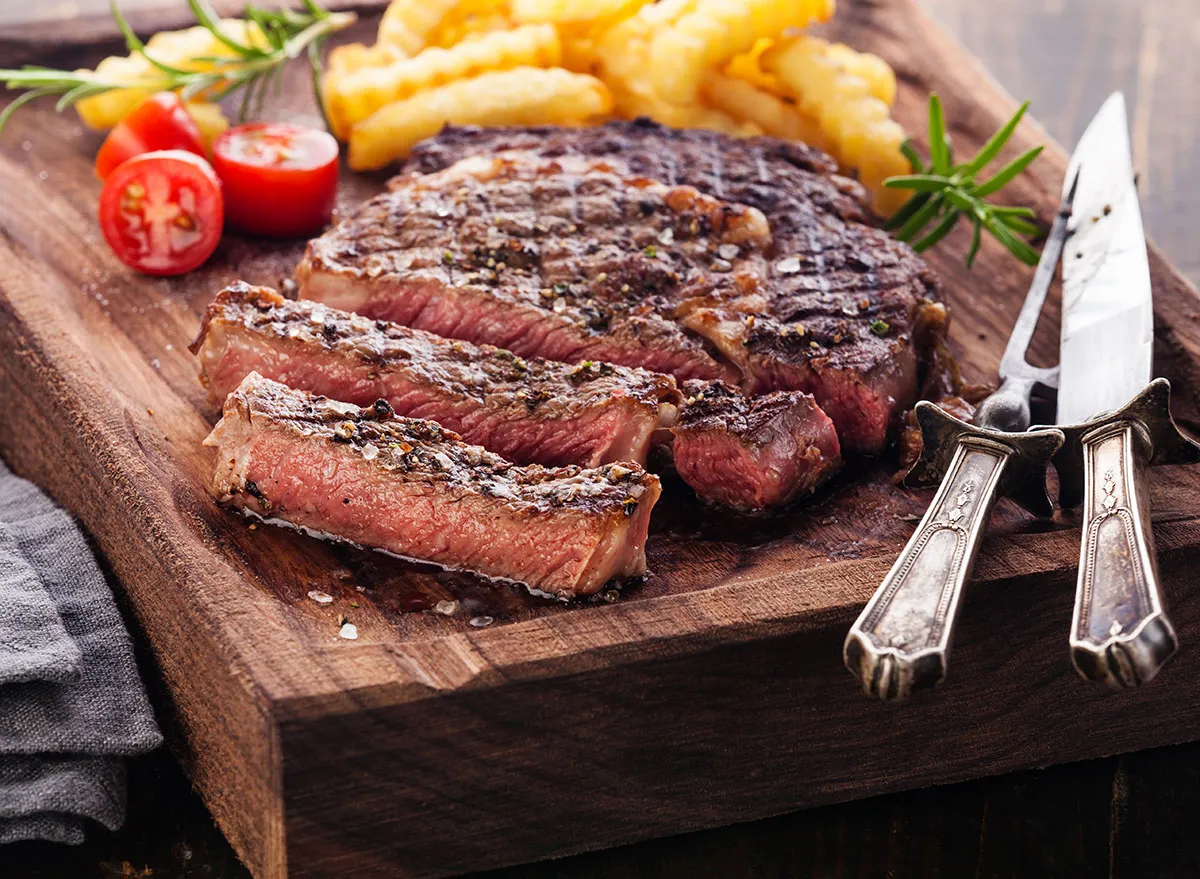
Calories: 289
Fat: 22 g (Saturated Fat: 10 g)
Sodium: 361 mg
Carbs: 0 g (Fiber: 0 g, Sugar: 0 g)
Protein: 24 g
There’s a reason this rich-tasting steak is so sought after (and ranks top of our list for the unhealthiest). From a steak nutrition standpoint, the ribeye is one of the most indulgent cuts, known for its high fat content. Sold as a prime rib when served as a rib roast or a Tomahawk when left on the bone, it’s highly marbled with fat, making each bite rich and juicy. Each 100-gram serving (about 3.5 ounces) of ribeye steak has 10 grams of saturated fat, almost 50% of the recommended daily limit.
While you don’t have to avoid this steak altogether, avoid the 16-ounce servings often sold in restaurants and select a reasonable 3- to 5-ounce portion instead.


